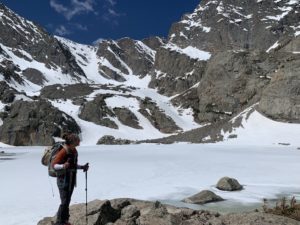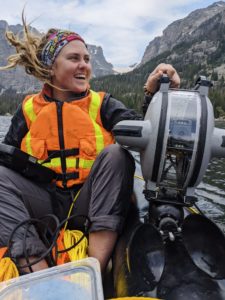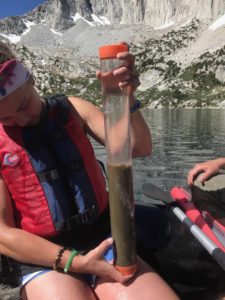
In honor of Women’s History Month, celebrated annually in the month of March, we highlight women in the Warner College of Natural Resources who are making change to create opportunity, invite and celebrate diversity and lend their voices to the natural resources fields.

Caitlin Charlton is a fourth-year master’s student in the Graduate Degree Program in Ecology. Her research interest lies in limnology with a specific focus on the effects of global change on mountain lake ecosystems, centered on changes to mountain lake algal productivity.
Charlton’s master’s degree research is focused on analyzing spatial and temporal drivers of change to mountain lake productivity in the Sierra Nevada, California, and looks at regional comparisons of change in lake productivity in mountain ranges across the western United States.
She also uses remote sensing and underwater photogrammetry approaches to map and monitor benthic algal blooms and pelagic lake productivity in the Loch Vale Watershed in Rocky Mountain National Park, with future goals to expand to other mountain regions.
Charlton also works to communicate CSU science and research as the communications coordinator for the Natural Resource Ecology Laboratory and serves as editor of the organization’s blog EcoPress. There she works on various science communication projects such as social media engagement, graphic design and writing news stories to make science more accessible to the every day person.
Q&A with Caitlin Charlton
Can you share with us a highlight in your student career?
The best part of my graduate research has been the field work. I have had the opportunity to travel into the backcountry in the Sierra Nevada to collect lake sediment cores, raft on high elevation lakes in all sorts of weather conditions across California, Colorado and New Mexico, and work in intense winter conditions above 10,000 feet in Rocky Mountain National Park. Being able to immerse myself in the environments I study has been something I will cherish for the rest of my life. It often feels like a dream that I got to spend week after week in some of the most beautiful mountain regions in the world.
A specific moment that will always stick with me was the first time I snowshoed up to The Loch during my first year as a graduate student. Walking across the lake at 10,000 feet with wind howling and snow blowing was one of the most inspirational moments I have had for both research and my love for the mountains. Everything has grown exponentially from that point, but that was one of the first moments where I felt like I was doing exactly what I had always been meant to do.
Do you have any women who have inspired you or mentored you in your NR studies?

My advisor, Jill Baron, is one of my biggest inspirations and had been an incredible mentor to have during my time at CSU. Jill’s former Ph.D. student, Bella Oleksy, who I overlapped with during my first year at CSU has also been an incredible mentor for me. They both have inspired and shown me how to mesh my passion for the outdoors and protecting our environment into meaningful scientific endeavors. We do some of the most physically challenging fieldwork there is, and the majority of us in the lab are women! It has been great to work beside so many talented women who are not only incredibly smart, but also have incredible physical abilities to do the intense field work we do.
What advice do you have for women entering this degree field?
I would tell all women entering this field that if you can dream it, you can find a way to make it happen. My project to map and monitor benthic algae in mountain lakes with underwater photogrammetry and underwater ROVs had not been attempted before. Finding people to work with that are supportive of big ideas and work life balance is crucial to success in grad school and in research, and I am so grateful to have found that here at CSU.
That being said, don’t be afraid to fail! One of my biggest pitfalls in graduate school was being afraid I was doing something wrong, or messing up, but science is filled with failure, imperfections and learning from our mistakes to create new and better projects. When trying new things and new research avenues, not everything will work out the first time around. Don’t be afraid to give big ideas a shot!